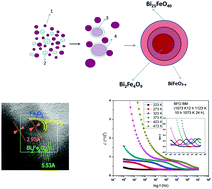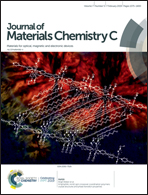Formation of bismuth iron oxide based core–shell structures and their dielectric, ferroelectric and magnetic properties
Abstract
Bismuth and iron oxides subjected to ball milling followed by controlled annealing treatments showed the formation of core–shell nanostructures with Bi2Fe4O9 as the core and a shell of BiFeO3 and Bi25FeO40 phases as deduced based on the analysis of transmission electron microscopy results. The mechanism of formation of such bismuth iron oxide based core–shell structures with Bi richer phases distributed radially outwards has been elucidated based on a model proposed in this study. Hyperfine components at Fe sites have been studied using Mössbauer spectroscopy to understand the local structure and magnetic properties and defect associated components of each of the phases. The system of such core–shell particles surrounded and separated by haematite particles is observed to be ferroelectric and exhibit a giant dielectric response. Bulk magnetization studies indicate weak ferromagnetic ordering of the resultant phases. Both the giant dielectric and weak ferromagnetic properties are understood to be caused mainly by oxygen vacancies associated with nanoshells of bismuth ferrite of the core–shell structures.



 Please wait while we load your content...
Please wait while we load your content...